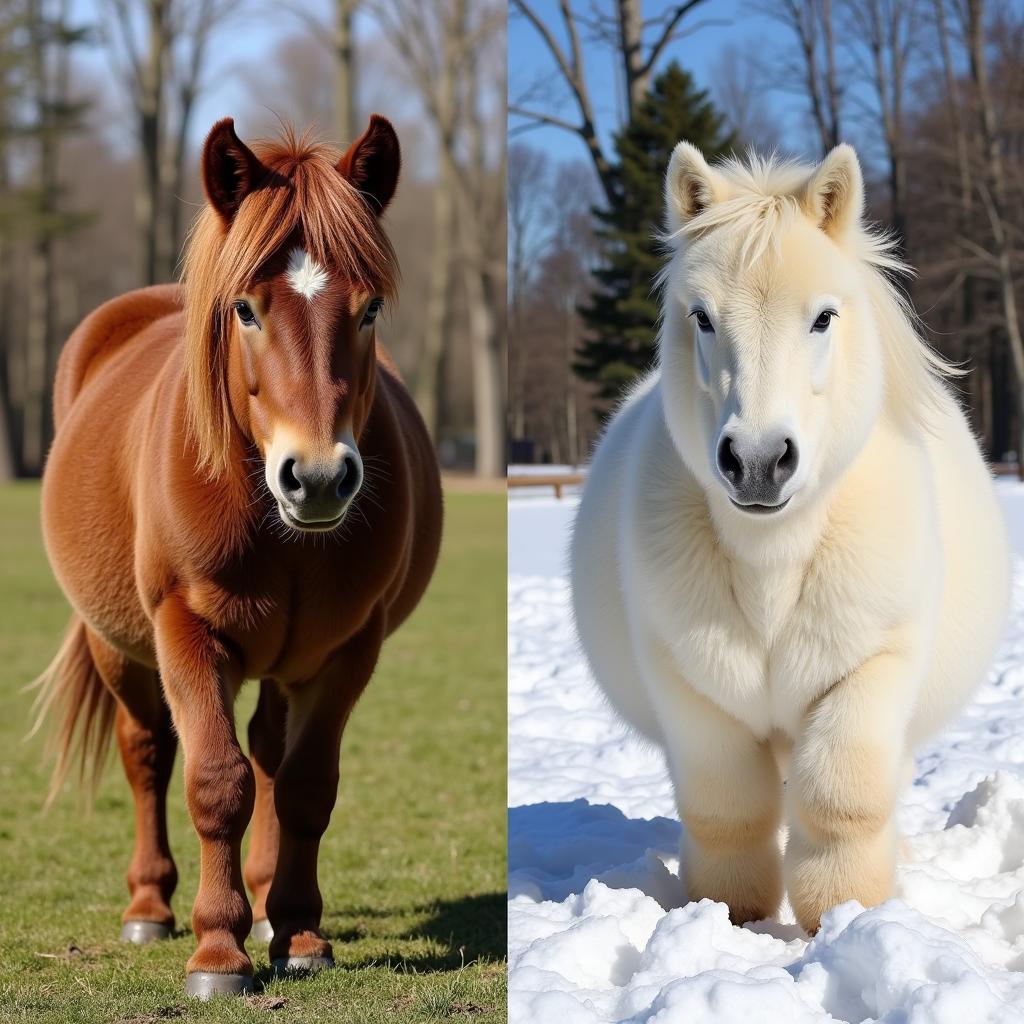A mini horse’s coat is much more than just a pretty covering. It’s a complex and vital part of their health and well-being, providing protection from the elements and playing a crucial role in thermoregulation. Understanding the nuances of the Mini Horse Coat, from its different types to proper care, is essential for any mini horse owner.
Decoding the Mini Horse Coat: Types and Textures
Mini horses, like their larger counterparts, boast a variety of coat types and textures, each designed for specific climates and purposes. From the sleek, short summer coat to the thick, shaggy winter coat, these adaptations help them thrive in diverse environments.
- Summer Coat: The summer coat is short, fine, and lies close to the skin, allowing for efficient heat dissipation. This helps keep the mini horse cool during warmer months.
- Winter Coat: As temperatures drop, mini horses develop a thick, long winter coat that provides insulation against the cold. This coat traps warm air close to the body, acting as a natural barrier against harsh weather.
- Combination Coat: During transitional seasons, mini horses sport a combination coat, a blend of the summer and winter coats. This offers moderate protection as the weather fluctuates.
 Mini Horse Summer and Winter Coat Comparison
Mini Horse Summer and Winter Coat Comparison
Caring for Your Mini Horse’s Coat: Tips and Tricks
Maintaining a healthy mini horse coat requires regular grooming and attention. Proper care not only enhances their appearance but also contributes to their overall health and comfort.
- Regular Brushing: Brushing removes loose hair, dirt, and debris, promoting healthy skin and a shiny coat. Use a variety of brushes, including curry combs, stiff brushes, and soft finishing brushes, depending on the coat type and season.
- Bathing: While not a frequent necessity, occasional baths can help remove stubborn dirt and grime. Use a gentle horse shampoo and conditioner, ensuring thorough rinsing to avoid skin irritation.
- Blanketing: In extreme weather conditions, blanketing can provide additional protection. Choose blankets appropriate for the temperature and climate, ensuring proper fit to avoid rubbing or discomfort. You can find various miniature horse supplies at retailers.
- Parasite Control: Regular deworming and fly control are essential for maintaining a healthy coat. Parasites can cause skin irritation, hair loss, and other health issues. For effective fly control, consider using a quality horse fly insect repellent.
 Essential Mini Horse Grooming Tools
Essential Mini Horse Grooming Tools
What Affects Mini Horse Coat Health?
Various factors can influence the health and appearance of a mini horse’s coat. Understanding these factors allows owners to address any potential issues promptly.
- Nutrition: A balanced diet is crucial for a healthy coat. Ensure your mini horse receives adequate protein, vitamins, and minerals.
- Genetics: Some mini horses are genetically predisposed to certain coat types and colors.
- Health Conditions: Underlying health issues can sometimes manifest as coat problems, such as dullness, hair loss, or skin irritation.
“A healthy coat is a reflection of a healthy horse,” says Dr. Emily Carter, DVM, specializing in equine medicine. “Proper nutrition and regular grooming are essential for maintaining a vibrant and healthy coat.”
 Mini Horse with a Healthy, Shiny Coat
Mini Horse with a Healthy, Shiny Coat
Mini Horse Coat Changes: What’s Normal?
Seasonal shedding is a natural process for mini horses. Understanding these changes helps owners differentiate between normal shedding and potential health concerns. Don’t be surprised if you’re picking up horse manure more often during shedding season! Looking for a Noriker horse for sale? Check out our listings! Or if you are in Missouri and are searching for a horse for sale Missouri might be a great place to start your search!
Conclusion
The mini horse coat is a fascinating and essential aspect of their biology. By understanding its different types, proper care techniques, and the factors that influence its health, you can ensure your mini horse maintains a beautiful, healthy coat year-round. Remember, a healthy coat is often a sign of a happy and healthy mini horse.
FAQ
- How often should I brush my mini horse?
- What type of brush is best for a mini horse’s winter coat?
- Do mini horses need blankets in the winter?
- How can I tell if my mini horse has a skin condition?
- What are the signs of a healthy mini horse coat?
- How does nutrition affect my mini horse’s coat?
- What are the common coat colors for mini horses?
Common Scenarios and Questions:
Scenario: My mini horse’s coat is dull and dry. What could be the cause?
Possible Causes: Poor nutrition, parasites, underlying health condition.
Scenario: My mini horse is shedding excessively. Is this normal?
Possible Answers: It depends on the season. Seasonal shedding is normal, but excessive shedding outside of shedding season could indicate a health issue.
Further Exploration:
For more information on caring for your mini horse, check out our article on miniature horse supplies.
Need help with pesky flies? Learn more about horse fly insect repellent.
Need assistance? Contact us! Phone: 0772127271, Email: [email protected]. Visit us at QGM2+WX2, Vị Trung, Vị Thuỷ, Hậu Giang, Việt Nam. We have a 24/7 customer service team.